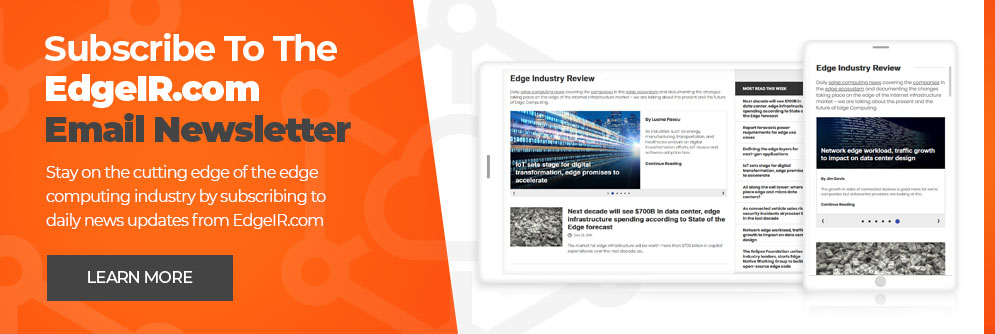The Next Evolution of the Cloud is at the Edge

By Phillip Marangella, Chief Marketing Officer at EdgeConneX.
The cloud is one of the most important tools in a CIO’s toolbox. It’s not about the infrastructure, it’s about what it enables: cost efficiency, delivery speed, value delivered, increased speed of innovation. It’s about competitive advantage.
No wonder enterprises are putting more and more production workloads and data in the cloud. Enterprise respondents to the Flexera 2020 State of the Cloud survey reported 48% of workloads and 45% of data are in the public cloud – figures expected to rise to 57% and 53% over the coming year.
But, as much as the cloud is a competitive necessity, it’s not that easy. It’s not that cheap. And it’s not that fast. No wonder 62% of enterprise cloud migration projects are reported to be “very difficult” or “failing.”
Wherever you are, your clouds should be
Enterprise IT environments are more distributed than ever, and the trend has been greatly accelerated as masses of formerly office-bound now work from home. And with the proliferation of IoT devices for many different types of enterprises, that extension goes even further.
Essential to low latency, high security, and cost-efficiency in this kind of distributed IT environment is your ability to get to all the clouds, public and private, from wherever you are.
The solution is a highly proximate cloud gateway data center, which eliminates capital outlays, alleviates network bottlenecks, reduces latency, and improves performance. Add an ecosystem of partners and you’ve got an optimized cloud journey.
Welcome to the hybrid multi-cloud ecosystem at the edge.
Cloud performance is better at the edge
Getting to the clouds through a highly localized edge gateway data center alleviates network bottlenecks, reduces latency, and improves performance. Peering at the edge enables these benefits by providing local, secure access to leading cloud services through cloud on-ramps.
It’s a solution Gartner calls distributed cloud computing – “the first cloud model that incorporates physical location of cloud-delivered services as part of its definition” – and it yields significant performance benefits.
The benefits of leveraging a cloud on-ramp alone are huge. Latency is cut in half when enterprises use the AWS Direct Connect on-ramp rather than public internet to get from a data center in Portland to AWS in Silicon Valley, for example.
Cloud cost is better at the edge
The benefits extend beyond performance. According to a report by ACG Research on hybrid cloud economics, there is an over 1600% difference between transport costs at the core versus the edge. Given that network transport costs are by far the biggest share of cloud TCO, bringing the public cloud to the enterprise edge can easily save millions.
The hybrid multi-cloud ecosystem at the edge drives other cost advantages as well. Multi-cloud saves money by optimizing the cloud provider for the workload; according to 451 Research, “U.S. customers can save half their cloud expenditure by mixing and matching services from multiple providers.”
Cloud security is better at the edge
There is nothing inherently less secure about the cloud. In fact, most public clouds and many private cloud providers can deliver far better security than the enterprise ever could. But there are challenges associated with migrating workloads into the cloud, and security challenges associated with transporting data via the public internet.
At the edge, the local cloud gateway enables you to get to the cloud via a dedicated private connection, which is far more secure than the public internet. And for global enterprises, localized clouds at the edge may be the only way to realize the full benefits of the cloud while adhering to local data sovereignty requirements and region-specific compliance regimes.
Cloud expertise is better at the edge
Just as managed service providers enable CIOs to fill their cloud security expertise gaps, ecosystem partners like MSPs as well as network, storage, security and other IT services providers can fill other expertise gaps and smooth the path to the cloud.
The competitive advantage is significant: enterprises that don’t have a hybrid multi-cloud ecosystem at the edge may face cloud migration delays of two years or more. Those that migrate securely and cost-efficiently can reap the rewards of the cloud today.
The next evolution of the cloud is at the edge
From where we stand today, enterprise use cases for latency-sensitive applications and compute-intensive end devices will continue to grow, pulling the cloud to the edge.
This won’t result in the cannibalization of the cloud by the edge. In practice, the edge will be a new tool in the CIO’s toolbox. Core cloud data centers will continue to play an essential role in enterprise success; so too will cloud gateway data centers at the edge. With a hybrid multi-cloud ecosystem at the edge, CIOs can actually realize the full promise of the cloud, to enable digital innovation.
About the author
Phillip Marangella is the Chief Marketing Officer at EdgeConneX.
DISCLAIMER: Guest posts are submitted content. The views expressed in this blog are that of the author, and don’t necessarily reflect the views of Edge Industry Review (EdgeIR.com).
Article Topics
application development | AWS | edge data center | edge ecosystem | EdgeConneX | interconnection


Comments